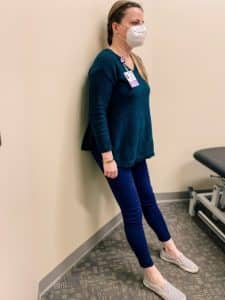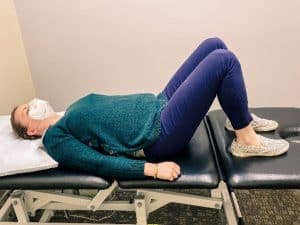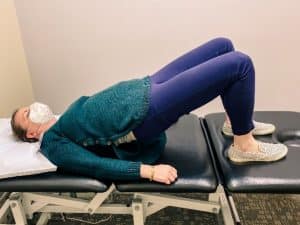5 Exercises for Hip Pain

Hip pain is a common complaint among people of all ages. One survey of people aged 60 and older found that 14% of respondents reported significant hip pain on most days during the last six weeks. Additionally, in young athletes, hip and pelvis injuries are common, with dancers experiencing the highest incidence at 44%.1
A number of different conditions can cause hip pain:
- Anterior hip pain, or pain at the front of the hip, is typically due to osteoarthritis, muscle strain, tendonitis, labral tear, or bursitis.
- Lateral, or side, hip pain is typically due to gluteus medius muscle dysfunction, iliotibial (IT) band syndrome, or greater trochanteric bursitis.
- Posterior hip pain, or pain in area of the buttocks, typically stems from the back or sacroiliac (SI) joint.1
Hip pain can have significant effects on function and quality of life, including:
- Difficulty walking, driving, stair-climbing, and housekeeping
- Higher levels of anxiety and depression
- Reduced work productivity in the form of greater absenteeism
- Sleep problems2
With a larger percentage of the population now 65 and older, hip pain due to osteoarthritis is likely to become even more of a public health concern.
Regardless of the cause of hip pain, it often leads to or is seen alongside decreased hip range of motion (ROM), weakness of hip and thigh muscles, impaired balance, impaired gait, and increased fall risk. Exercise has been shown to reduce pain, improve strength, and improve physical function in people with hip pain.3,4,5,6
Here are 5 exercises that can help improve strength, flexibility, balance, and stability. If you find any of these exercises to be painful, please do not perform that exercise.
5 Exercises for Hip Pain
- 3-Way Hip in Standing



Stand near a support such as a railing, chair, or countertop and hold on for balance assistance if needed. Keeping your knee straight, kick your leg forward, making sure not to lean back. Repeat this 10-15 times on each leg. Next, kick your leg out to the side with the toes facing forward, again making sure not to lean over. Repeat 10-15 times on each leg. Finally, kick backward, making sure not to arch your back or lean forward. Repeat 10-15 times on each leg.
- Standing Marching


Stand near a support such as a railing, chair, or countertop and hold on for balance assistance if needed. Lift your knee as high as you can, then lower it back down and raise the other knee as high as you can. Repeat 10-15 times on each leg.
- Wall Squats


Stand with your back against a wall, feet out and hip-width apart. Slide down the wall, as if sitting in a chair. Make sure your knees and hips don’t bend more than about 90 degrees and make sure your knees stay behind your toes. (You may need to bring your feet further forward if your knees bend over your toes.) Then, push through your legs and slide back up into standing. Repeat 10-15 times.
- Hip Bridges


Lie on your back. Squeeze your buttocks muscles and lift your hips off the support surface into a bridge. Hold this position for about 5 seconds, then bring your hips back down to the support surface. Repeat 10-15 times.
- Stair Hip Flexor Stretch

Stand up straight facing a step. Place one foot firmly on the step. Stand up straight, tighten your buttock muscles, and push your hips forward, keeping your back knee straight. You should feel a stretch in the front of your hip of the back leg. Hold this position for 30 seconds. Repeat 3-4 times, then switch feet so the opposite foot is now on the step.
If you are experiencing hip pain, Sheltering Arms Institute’s physical therapists can create individualized exercise programs tailored to your needs or specific diagnosis. Click here to request an appointment, or call (804) 764-1000.
References
- Margo, K., Drezner, J., & Motzkin, D. (2003). Evaluation and management of hip pain: An algorithmic approach. The Journal of Family Practice, 52(8), 607–617.
- Bennell, K. (2013). Physiotherapy management of hip osteoarthritis. Journal of Physiotherapy, 59(3), 145–157. https://doi.org/10.1016/s1836-9553(13)70179-6
- Abbott, J. H., Robertson, M. C., Chapple, C., Pinto, D., Wright, A. A., Leon de la Barra, S., Baxter, G. D., Theis, J.-C., & Campbell, A. J. (2013). Manual therapy, exercise therapy, or both, in addition to usual care, for osteoarthritis of the hip or knee: A randomized controlled trial. 1: Clinical effectiveness. Osteoarthritis and Cartilage, 21(4), 525–534. https://doi.org/10.1016/j.joca.2012.12.014
- Jigami, H., Tsubaki, A., Tokunaga, Y., Endo, N., Sato, D., Ishikawa, T., Dohmae, Y., Iga, T., Minato, I., & Yamamoto, N. (2012). Effects of weekly and fortnightly therapeutic exercise on physical function and health-related quality of life in individuals with hip osteoarthritis. Journal of Orthopaedic Science, 17(6), 737–744. https://doi.org/10.1007/s00776-012-0292-y
- Krauß, I., Steinhilber, B., Haupt, G., Miller, R., Martus, P., & Janßen, P. (2014). Exercise therapy in hip osteoarthritis. Deutsches Ärzteblatt International, 111, 592–599. https://doi.org/10.3238/arztebl.2014.0592
- Bearne, L. M., Walsh, N. E., Jessep, S., & Hurley, M. V. (2011). Feasibility of an exercise-based rehabilitation programme for Chronic Hip Pain. Musculoskeletal Care, 9(3), 160–168. https://doi.org/10.1002/msc.209